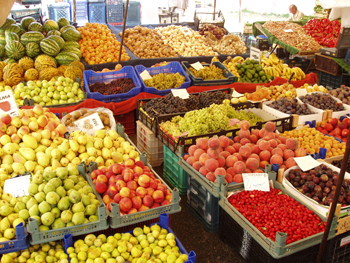Producers to save thousands with routine marketing strategies, says UFS researcher
 Photo: en.wikipedia.org |
Using derivative markets as a marketing strategy can be complicated for farmers. The producers tend to use high risk strategies which include the selling of the crop on the cash market after harvest; whilst the high market risks require innovative strategies including the use of futures and options as traded on the South African Futures Exchange (SAFEX).
Using these innovative strategies are mostly due to a lack of interest and knowledge of the market. The purpose of the research conducted by Dr Dirk Strydom and Manfred Venter from the Department of Agricultural Economics at the University of the Free State (UFS) is to examine whether the adoption of a basic routine strategy is better than adopting no strategy at all.
The research illustrates that by using a Stochastic Efficiency with Respect to a Function (SERF) and Cumulative Distribution Function (CDF) that the use of five basic routine marketing strategies can be more rewarding. These basic strategies are:
• Put (plant time)
• Twelve-segment pricing
• Three-segment pricing
• Put (pollination)(Critical Moment in production/marketing process), and
• Pricing during pollination phase.
These strategies can be adopted by farmers without an in-depth understanding of the market and market-signals. Farmers can save as much as R1.6 million per year on a 2000ha farm with an average yield.
The results obtained from the research illustrate that each strategy is different for each crop. Very important is that the hedging strategies are better than no hedging strategy at all.
This research can also be applicable to the procurement side of the supply chain.
Maize milling firms use complex procurement strategies to procure their raw materials, or sometimes no strategy at all. In this research, basic routine price hedging strategies were analysed as part of the procurement of white maize over a ten-year period ranging from 2002–2012. Part of the pricing strategies used to procure white maize over the period of ten years were a call and min/max strategy. These strategies were compared to the baseline spot market. The data was obtained from the Johannesburg Stock Exchange’s Agricultural Products Division better known as SAFEX.
The results obtained from the research prove that by using basic routine price-hedging strategies to procure white maize, it is more beneficial to do so than by procuring from the spot market (a difference of more than R100 mil).
Thus, it can be concluded that it is not always necessary to use a complex method of sourcing white maize through SAFEX, to be efficient. By implementing a basic routine price hedging strategy year on year it can be better than procuring from the spot market.
Understanding the Maize Maze by Dr Dirk Strydom and Manfred Venter (pdf) - The Dairy Mail